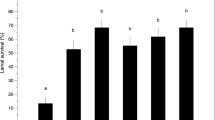Abstract
Specimens of the Arctic Collembolon Onychiurus arcticus were exposed to desiccation at several subzero temperatures over ice and at 0.5 °C over NaCl solutions. The effects of desiccation on water content (WC), body fluid melting point (MP), supercooling point (SCP) and survival were studied at several acclimation temperatures and relative humidities. Exposure to temperatures down to −19.5 °C caused a substantial and increasing dehydration. At the lowest exposure temperature unfrozen individuals lost 91.6% of the WC at full hydration but more than 80% of the individuals survived when rehydrated. Exposure at 0.5 °C to decreasing relative humidities (RH) from 100% to 91.3% caused increasing dehydration and increasing mortality. Survival of equally dehydrated individuals was higher at subzero temperatures than at 0.5 °C. Concurrent with the decline in WC a lowering of the MP was observed. Animals exposed to −3 °C and −6 °C over ice for 31 days had a MP of −3.8 and < −7.5 °C, respectively. Specimens from a laboratory culture had a mean SCP of −6.1 °C, and acclimation at 0 or −3 °C had little effect on SCPs. Exposure at −8.2 °C over ice for 8 days, however, caused the mean SCP to decline to −21.8 °C due to the severe dehydration of these individuals. Dehydration at 0.5 °C in 95.1 and 93.3% RH also caused a decline in SCPs to about −18 °C. Individuals that had been acclimated over ice at −12.4 °C or at lower temperatures apparently did not freeze at all when cooled to −30 °C, probably because all freezeable water had been lost. These results show that O. arcticus will inevitably undergo dehydration when exposed to subzero temperatures in its natural frozen habitat. Consequently, the MP and SCP of the Collembola are substantially lowered and in this way freezing is avoided. The increased cold hardiness by dehydration is similar to the protective dehydration mechanism described in earthworm cocoons and Arctic enchytraeids.
Similar content being viewed by others
Author information
Authors and Affiliations
Additional information
Accepted: 5 January 1998
Rights and permissions
About this article
Cite this article
Holmstrup, M., Sømme, L. Dehydration and cold hardiness in the Arctic Collembolan Onychiurus arcticus Tullberg 1876. J Comp Physiol B 168, 197–203 (1998). https://doi.org/10.1007/s003600050137
Issue Date:
DOI: https://doi.org/10.1007/s003600050137




